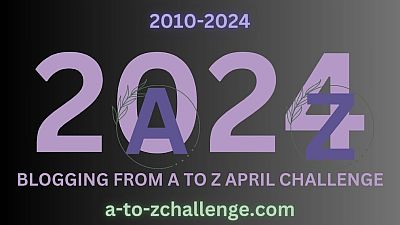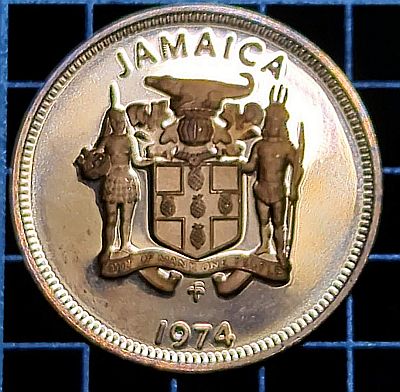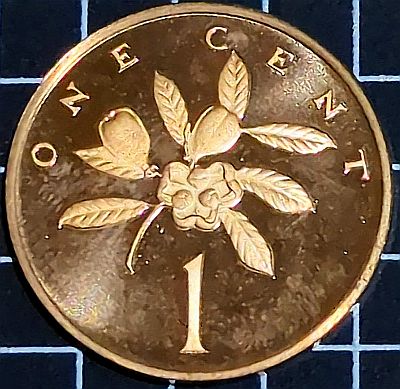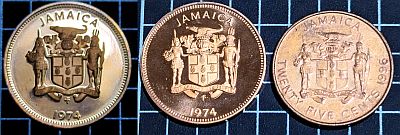A very shiny cent from a newly independent country
This is a bonus entry for Day 24 “X” of the Blogging from A-Z April Challenge!
X = Xaymaca (Jamaica).

Independence
As noted yesterday, there are very few coin issuing entities which begin with X. Jamaica is known as Xaymaca in the native language, so we’ll go with that as an “X” country. If you know of any others, please let me know so I can plan for next year!
Also as covered in yesterday’s United Fruit Company Tally, Jamaica endured a long, often violent colonial history at the hands of the Spanish and then British. Under both empires, slaves were brought from Africa to work the plantations on Jamaica. Slavery was officially abolished in Great Britain in 1807. The movement took longer to be fully realised in the colonies, with emancipation in Jamaica finally won in 1838.
The end of slavery brought about the collapse of the traditional plantation system, as the West African slaves who had fought for their freedom were no longer prepared to work for their former masters. This, together with other factors, including unemployment, heavy taxation, droughts and dissatisfaction with the colonial system, led to uprising and riots at various times from the 1860s to the 1930s.
The riots of the 1930s saw the rise of the first labour unions, and political parties linked to them. A growing demand for self-determination, and political agitation led to a new constitution in 1944. This constitution provided for a two-party House of Representatives, the appointment of Ministers and universal adult suffrage. Further constitutional advances took place in 1953 and 1957, and full internal self-government was obtained in 1959. On August 6, 1962, after 300 years of British colonization, Jamaica became an independent nation with full dominion status within the Commonwealth.
Currency
In the early colonial period, Jamaica used Spanish, or Spanish-American (such as from Peru) “Real” coinage. This was countermarked with the king’s monogram or mark. This continued after the British captured Jamaica (1655) through to 1822. In 1822 the first British coins to be used in Jamaica in denominations of ¼, 1/8, 1/16 dollar. These came to be known as ‘anchor money’ because of the design. These coins were used not just in Jamaica, but across the “British West Indies”.
The British West Indies encompassed 18 different countries:
- Anguilla,
- Antigua and Barbuda
- Bahamas
- Barbados
- Bermuda
- British Virgin Islands
- Belize (formerly British Honduras)
- Cayman Islands
- Dominica
- Grenada
- Guyana (formerly British Guiana)
- Jamaica
- Montserrat
- Saint Lucia
- Turks and Caicos
- Saint Vincent and the Grenadines
- Trinidad and Tobago
- Saint Kitts and Nevis
In the 1860s-1880s, new Jamaican coins were introduced. These featured Queen Victoria with her title and year on the obverse. The coat-of-arms with the country name and denomination was on the reverse.
Obverse

The obverse of the coin features the coat-of-arms of Jamaica, with supporters. The country name is above and year below. Aside from this side of the coin featuring the year rather than the denomination, the layout is broadly unchanged since coins issued under Queen Victoria.
The original Coat of Arms granted to Jamaica in 1661, was designed by the then Archbishop of Canterbury, William Sanderoft. Apart from a partial revision in 1957, it remains virtually the same as was originally designed. The Arms shows a male and female Arawak, standing on either side of the shield which bears a red cross with five golden pineapples superimposed on it. The Crest is a Jamaican crocodile surmounting the Royal Helmet and Mantlings. The original Latin motto, “Indus Uterque Serviet Uni”, has been changed to one in English: “Out of many one People”.
Reverse

The other side of this coin is quite different to those issued previously. Even past independence, up until 1969, Jamaican coins kept the monarch (Elizabeth II by 1969) on one side of the coin. In 1969, Jamaica moved from a pound system (based on the British pound – 12 pence to the shilling, 20 shillings to the pound), to a decimal system (100 cents = 1 dollar). The new coins featured the coat-of-arms on the obverse now, with native plants and animals on the reverse.
The reverse of the one-cent coin features Ackee fruit (Blighia sapida). Like the tomato, the Ackee fruit is often cooked like a vegetable. The fruit opens naturally when it is ripe and ready to eat. Interestingly, it is unwise to force the fruit open prematurely, as prior to ripening, the fruit can contain toxic levels of hypoglycin. Ackee fruit are members of the same family as Lychees, and the same thing can happen with both fruits.
:max_bytes(150000):strip_icc():format(webp)/Ripeackee-GettyImages-122632370-59a853789abed50011be6355.jpg)
Ackee fruit which are ripe and split open, showing the seeds inside, from TheSpruceEats.com
Proof coins
Proof coins are designed to be beautiful collector pieces. They are not intended for circulation. In some cases, proof coins may feature designs the same as their circulating counterparts, or they may be completely different designs.
Reading the United States Mint explanation (it is similar for other mints): “Proof blanks are specially treated, hand-polished, and cleaned to ensure high-quality strikes. The blanks are then fed into presses fitted with specially polished dies and struck at least twice. The coins are then carefully packaged to showcase and preserve their exceptional finish.”

Here are two photographs of the proof 1974 Jamaica one cent coin, in different light, next to a later 1996 twenty-five cent circulation coin. Note the way the fields (blank areas) on the proof coin are particularly smooth and shiny, and the design appears frosted and really stands out.
In this case, the 1974 Proof cent (which was issued for collectors from 1971 – 1975) uses the same design that was struck for circulation from 1969 – 1971. The key difference is that the text on the obverse (country and year) are narrower on the proof coin than on the circulation coin. The coin was also minted at the Franklin Mint, United States, where the circulation coin was minted by the Royal Mint, UK. As such, the design also incorporates the FM mintmark of the Franklin Mint, just under the ribbon at the bottom of the coat-of-arms.
On the post for one of the first coins I featured on the page, the 1984 Hungary 2 Forint, I also included a photograph of a proof silver version of that piece. Do you collect proof coins? What is your favourite proof coin? Let us know below.


Leave a Reply